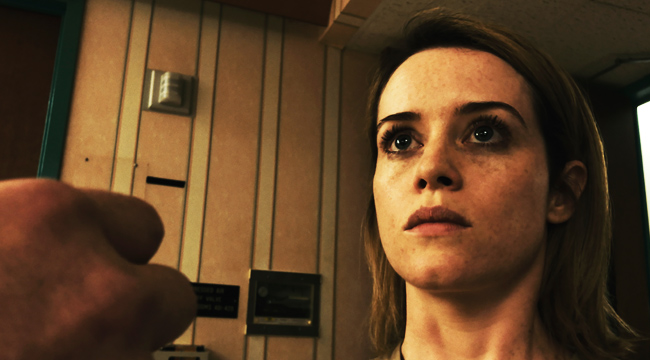
Watching Stephen Soderbergh’s Unsane is like being locked in a circus cage with a tiger. The camera — specifically Soderbergh’s iPhone camera — is loose-limbed, prowling, restless. The actors’ distorted faces and hands aggressively poke at your eyes. His leading lady Claire Foy, playing a nervous bank employee named Sawyer Valentini, talks fast and walks faster, high heels clawing furiously down the sidewalk while Soderbergh shoots her through bushes and trees. She looks hunted. And she is, although instead of one predator, the script confuses us with a three-pronged assault, like a ringmaster’s stool. We’re not sure what enemy to focus on: The stalker (Joshua Leonard) she’s fleeing? The insurance-scamming doctors who will lock Sawyer in a mental hospital? Or is the real problem Sawyer herself, whose violent hallucinations of her hairy pursuer leave several characters bruised. When her shady doctor insists she’s a danger to herself and others, it’s hard to disagree.
Is Sawyer crazy or stable? She’s neither and both, a topsy-turvy diagnosis captured in the title, which nods to Lewis “Unbirthday” Carroll. Foy plays her like a survivor, not a victim. Squint and she’s also an accomplice. There is something wobbly about her, besides an accent that shifts from Southern belle to East Coast growl like the Brit-born Foy is auditioning for Sybil. Foy gives her eyes that are a little too sharp and a smile that’s too forced. At the office, she’s so rude her co-workers roll their eyes behind her back, and on a Tinder date, she yelps, “Hail Satan!” Sawyer’s aware she doesn’t have friends, and doubly aware that’s a red flag. When mom (Amy Irving) nudges to see if she’s made work buddies, she lies. Sawyer admits she’s impulsive, and demonstrates that she’s manipulative. We see Foy flip her fake charm on and off like a pageant queen, attempting to convince physicians that she’s too rational for psychosis. Locked away, however, Sawyer starts throwing haymakers at orderlies. And when she meets the hospital’s whispery new nurse (also played by Leonard), she shrieks. It’s her stalker in disguise. Isn’t it?
Soderbergh’s less interested in her diagnoses — may I suggest “pogonophobia,” the fear of facial hair — then her plummet down the rabbit hole from office cubicle to basement padded cell. Outside, especially in the opening shot of a neon-purple dappled forest, the world can look sinister and surreal. But once Sawyer’s trapped in Highland Creek, Soderbergh cranks the saturation down to the sour amber of a dirty pipe. She’s dubbed Alison by her new roommate Violet (a slithery, braided Juno Temple) and blasts out a distress signal that pings off two chubby cops as useless as Tweedledee and Tweedledum.
Like Wonderland, the psychiatric ward functions on ouroboros logic. A sane person would be furious to be wrongfully committed. Except the therapists blame Sawyer’s anger to justify locking her up. If she wants to be released, she’ll have to grin like everything is great while being groped, handcuffed, starved, stripped of reason, and ordered to drink mysterious potions. If she wasn’t unhinged already, someone slips her a brain-scrambler that inspires Soderbergh to superimpose her ponytail over her face in a manic fritz. Yet, it’s Sawyer’s desperation to get away from tampon-throwing Violet—to get back to her calm, boring desk — that makes her sound unhinged. Instead of talking to Sawyer logically, aides burst in and out of rooms in coordinated confusion, taking away handfuls of her freedom until she’s dug into a warren of dead ends. As Alice sighed to the Cheshire Cat, “But I don’t want to go among mad people.”
“Oh, you can’t help that,” said the Cat. “We’re all mad here. I’m mad. You’re mad.”
“How do you know I’m mad?”
“You must be—or you wouldn’t have come here.”
The mental hospital scenes are terrifyingly banal. They’re clipboard tyranny, and that’s plenty to make us curl up our fists. “Highland Creek is just like any other business in America,” nods eerily calm fellow inmate Nate (Jay Pharoah), an ex-heroin addict who’s the sanest character in the film. He advises Sawyer to shut up and smile, joking that when he gets out, he’ll better himself with a degree from the University of Phoenix, as though troubled Americans are only free to contract their lives to a slightly kinder scam.
Unsane isn’t quite a thriller. That would imply a coherent villain. Instead, it swipes through themes like an Instagram filter. Unsane starts as a heavy-breathing De Palma pursuit, transforms into a health care satire, and mutates to become a #MeToo allegory about a woman screaming to be heard. It’s sickly perfect that the more Sawyer yells, the more aware we are that she’s in a straitjacket while her assailant walks free. Soderbergh mainly wants to prove he can create something kinetic and cheap that feels like a real film. It has a run and gun urgency that pairs well enough with Sawyer’s serialized, barely connected misadventures. In one scene, Leonard mutters, “To be continued” — an apropos threat.
Toward the end, Soderbergh layers all his ideas on top of each other and the message becomes muddy gray. Maybe we’re just crazy for thinking he had a message at all, or maybe something this fleet can get away with just setting a mood. Yet, even if the film is ultimately unreliable, Foy reveals moments of clarity. There’s a terrific scene where she emotionally eviscerates Leonard, and a sickening escape attempt when we see she’s capable of hurting innocent people, too. But the most gut-clenching scene is also the film’s most mundane, a flashback where a safety consultant (a cameo by Matt Damon) lectures Sawyer on how to protect herself from dangerous men. Change her apartment, her parking spot, her work hours, her phone number, he advises, and delete Facebook. Even before doctors hide her out of sight, she’s forced to erase her own existence, a vanishing tigress left only with a phony grin.






